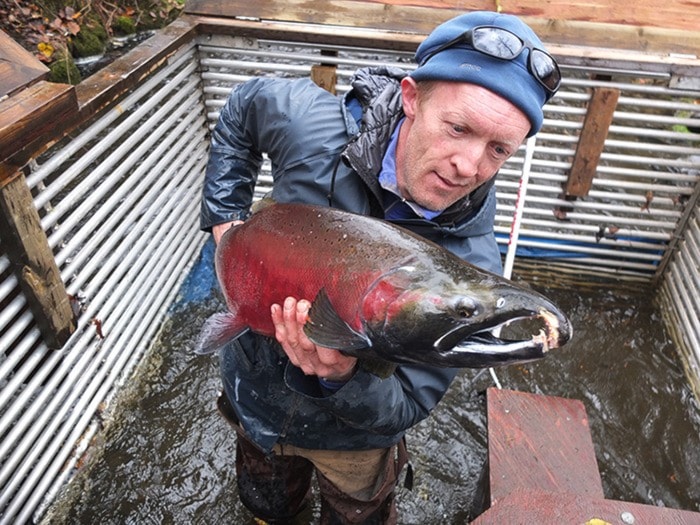Two decades since volunteers in the Hazeltons set about restoring a coho salmon population of only a few breeding pairs, 1,500 fish have arrived at a local spawning ground with a little help from a handful of dedicated people.
About 20 years ago, a culvert built under Highway 16 put a wall between the coho salmon in Mission Creek, near South Hazelton, and their natural spawning habitat at Waterfall Creek.
To help the fish complete their migration, a group of volunteers set up a fish hatchery at Chicago Creek and a simple fish fence at Mission Creek.
From the fish fence, the salmon were captured and transported to Waterfall Creek.
Project manager Mark Larsen, who has been with the project for about 13 years, remembers the volunteers had a basic system for moving the fish.
“It was pretty simple at first and they were carrying fish out in buckets and through the bush,” Larsen said.
“It’s come quite a long way to the point that last year that we had a complete rebuild with some support from CN and from the Department of Fisheries.”
The upgraded fish fence is a permanent structure with a removable pen which captures the fish during the spawning season between August and November.
Using a custom-built trailer with a tank and oxygen, a generator and a water pump, the volunteers truck about 15 to 18 fish at a time from the capture pen to their spawning beds at Waterfall Creek.
The original hatchery at Chicago Creek is no longer used because the property changed hands, so for the past five years the fish that pass through the fence are from a self-sustaining population.
Last year 560 fish passed through the fence, a record at that time, and Larsen said projections this year suggested numbers would drop to about 150 coho in 2014.
Instead, the salmon arrived in huge numbers. Since the season started in August, about 1,500 fish have been collected from the capture pens in a bumper year for the species.
Larsen said the influx took the volunteers by surprise.
“We generally have two peaks, one in September and one in about the middle of October and once we hit October they just started coming like we have never seen before,” he said.
“There were three days where we had over 200 fish.
“It was just ridiculous, wall to wall fish, we had never seen it like that.”
Larsen said it was not clear what caused such a significant increase in fish numbers but he said it was possible the fish had avoided the Alaskan fisheries by starting their migration later than usual.
“We’re not quite sure why the survival rate is so outstanding this year,” he said.
“This is just incredible.
“We’ve never had the problem where we have too many fish.”
The number of fish saturated the spawning habitat at Waterfall Creek so some of the captured salmon had to be put back into Mission Creek.
Larsen said the Society had started discussing ways to increase the amount of spawning habitat in the area.
“We have done some work this last year making spawning beds downstream of the culvert but you’re not allowed to put the fish into different watersheds so there is only so much we can do.”
He said one option could be to get a licence to harvest and sell the fish but that it was still under consideration.
